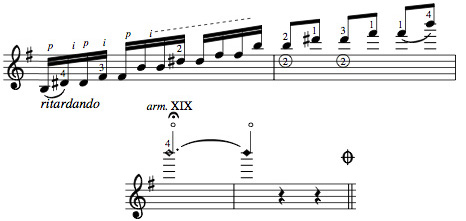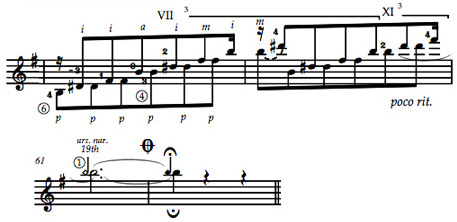Following on from parts 1 and 2, let’s look at the end of the opening section, in the piano original an arpeggiated flourish spanning five octaves in the dominant key of D major:

This poses a problem for guitar transcriptions as the guitar has a range of roughly three and a half octaves. In the key most guitar transcriptions are in, Em, this becomes a B major arpeggio, only giving a range of three octaves. Forte dramatically changed this section – the arpeggio is shortened with the semi quavers of the original being replaced by triplets spanning just one bar, giving a 3 octave arpeggio. This effectively solves the problem of range, but gives a much more subdued effect than the original’s spectacular five octaves of semiquavers. He finishes with a 19th fret harmonic for the final high B, using some artistic license in using a technique not available to the piano.

Prat’s arpeggio has one bar of semiquavers in the same pattern as the original, followed by one of quavers – slowing down the rhythm by half and avoiding running out of range. Like Fortea he ends with a 19th fret harmonic for the final high B.

Segovia uses a three octave arpeggio of quavers, with a pizzicato effect added. The technique of pizzicato has no equivalent technique on the piano, so he is clearly adding something to the score not alluded to in the original. Like Fortea, the overall effect is quite subdued compared to the original.

Yates has an arpeggio very close to the original, with the same repeated semi quavers over two bars. He drops an octave in the second beat of bar 60, to avoid exceeding the guitar’s range, and adds a 19th fret harmonic at the end, in common with the other three transcriptions I’ve looked at.

Four quite different solutions – in my opinion Yates’ is the only one that does the section justice.
